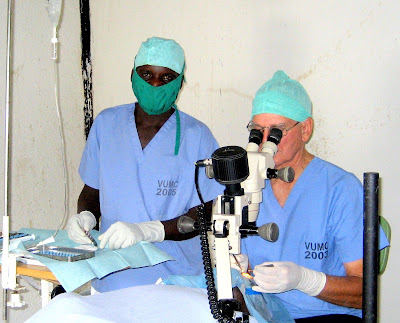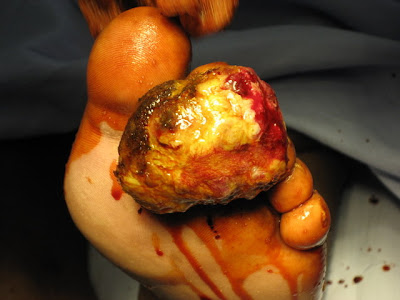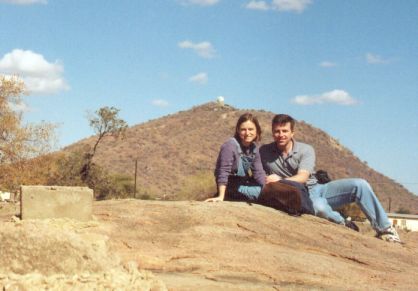Himba breast exam
At one point we took care of a prominent Himba chieftan for urologic concerns. The Himba ethnic group live in southern Angola and northern Namibia. They are a beautiful, proud, friendly, and pastoral people. They have resisted pressures to westernize and hence have maintained a strong cultural identity. For example, daily beauty care for Himba women includes a full-body treatment with a cream made of rancid butterfat, an aromatic bush resin, and red ochre mud – which lends the intense reddish shine to Himba skin.
While our patient was recovering, his wife (they are both pictured above) became friendly with a North American friend of ours who worked at CEML for a few months – we’ll call her Sally. Our patient’s wife became concerned that Sally (in her mid-twenties) was neither married, nor had any children. There must be a reason for this, she insisted.
“In North America, we tend to marry later,” Sally tried to explain through Kayove, CEML’s number 2 administrator and the only speaker of Himba at the Hospital. He was growing increasingly uncomfortable in this role.
“No, there must be more to it than that,” reasoned our Himba lady. “Perhaps you’re not of age yet; it’s hard to tell how old you are with all those clothes on.”
The conversation escalated this way with Kayove (now squirming) having to translate our Himba lady’s impression of Sally’s post-pubescent maturation. Finally, before Sally could react, the Himba lady had plunged her had down Sally’s blouse, giving her a bilateral breast exam. Withdrawing her hand, she sagely concluded… “I was right, you must be very young.”
Got Milk?
Angola’s fertility rate, as with much of sub-Saharan Africa, is about 6 children born to every woman over her lifetime. This means that there are always children around you being breastfed. And this is great – it helps prevent malnutrition, diarrhea, and pneumonia, the diseases that kill the most number of infants in Africa. Generally, it seems moms have little trouble with lactation, and it’s rather common to have one or two babies breastfeeding while seeing mom in the clinic. Once, however, Beth had a patient come in with the chief complaint that she wasn’t producing milk, and wanted formula for her baby. Not having dealt with this problem before, she called in our dear colleague Dra. Arminda. Arminda is an American-trained, Angolan pediatrician who works both in public health and at CEML. Arminda took the same history from the patient. “That’s not right,” she said, unsatisfied, “all our moms can make milk.” At this point she reached down the patients blouse, produced her breast, and gave it a vigorous squeeze, squirting milk across the clinic room. “See, it’s not a problem.”
Like a cabrito
About a quarter of the patients we saw in outpatient clinic came in with primary complaints of migratory abdominal pains that could manifest in a variety of ways. Some have had a burning intermittent, bloating discomfort for years. Others are concerned about the bicho – creature – in their bellies causing the discomfort. Still others are quite certain of the cobra that lives inside of their abdomen, with the head in the left upper quadrant, which bites them incessantly. At first this was a bit bewildering. Then the pattern came clear. 90% of these patients suffer from constipation – a result of their maize meal (everyone’s staple) having become so refined and processed that all roughage has been removed. This lack of fiber combined with chronic mild dehydration makes for a tough set-up for the GI tract. The rest of the interview was almost always the same.
“Any vomiting or diarrhea?”
“No.”
“Any fevers?”
“No.”
“Blood in your stool?”
“No.”
“How often do you stool – twice a day, once a day, once a week?”
“Once a week… how did you know?”
“Is your stool soft and bulky, or small and hard?”
“Small and hard.”
“Ah, sim. Como um cabrito?” ("Ah, yes, like a goat’s?")
Then the eyes light up with profound acknowledgement, as if the doctor had been given some special powers of insight – they must know! At this point the prescription is given: lots of water, vegetable high in roughage, and farelo - bran. This last one is most important in keeping that pesky cobra from biting.
Hot sex
The next few entries are dedicated to some of the more unusual patient complaints we heard over the year. In May, as another late clinic day was near wrapping up, Beth had a 55 year old man who had been waiting since 8am to be seen by a doctor.
“I have burning down there,” he stated, pointing to his genital area.
This wasn’t terribly surprising. In our experience, many pains and discomforts in our Angolan patients manifest as heat and burning, often migrating around the body. Sure enough, his burning would start in his loins, head up his belly, fill his chest, and then ascend his neck and head like fire. Reflexively, Beth started filling lab slip to check for sexually transmitted diseases.
“But what is strange,” he pressed on, “is that my wife gets it too!” When they have sex, she too gets the burning “down there,” which then envelopes her whole body. And it happens to both of them at the same time!
A bit perplexed as to how to react, Beth gave him the lab order, just to make sure; wrote down in his chart that indeed “the sex is hot”; and sent him on his way with her congratulations.
Lost wisdom
A month earlier Beth saw a 25 year old man in clinic, complaining that he would intermittently lose his wisdom. Scanning his chart, she read the detailed triage note from earlier that day from our friend and housemate, Shelley Duplantis, an advanced practice nurse, confirming the same.
“So tell me what’s wrong...”
“Well, doctora, you see I’ve been losing my wisdom.”
“What do you mean? How does this happen?”
“Well it starts as a burning in my stomach, and then it goes to my back. And then it climbs into my chest, heads up my neck and into my head. Then I go crazy. And then I lose my wisdom!”
Huh. OK.
“So, umm… did anybody come with you today? Maybe they can help us out.”
“Oh yes, my friend came – he’s out in the hall.”Enter friend.
“So can you tell me what happens to you friend here?”
“Oh yes, you see, it all starts as a burning in his stomach, and then it goes to his back. And then it climbs into his chest, heads up his neck and into his head. Then he goes crazy. And then he loses his wisdom!”
A bit at a loss, she wrote him for penicillin to treat his syphilis, though admittedly he had no signs of neurosyphilis, and asked him to follow-up when he’d finished his treatment.
O Pensador - the Angolan Thinker is a national heritage icon.
He even is printed on every kwanza bill, the national currency.
Sadly, he now reminds me of our young man losing his wisdom.
Credit to Ben and Julia Martens, the photographers.
Pulsation in the abdomen
I had an 18 year old young man present to the office with abdominal complaints. Having just seen 4 patients in row all needing farelo (see above), I had to work hard to not roll my eyes back into my head.
“So, what’s wrong with your belly?”
“Oh doc, it’s bad. I think I am going to die!”
I looked him. He was tall, thin, muscular; appeared to be the picture of health.“What on earth could be so bad?”
“I’ve got this thing in my belly. I noticed it months ago, and it won’t go away. It comes back every night as I lay down. It just sits there and pulses. I think it will kill me.”
I laid him down on the exam table… sure enough, he had a perfectly normal aorta coursing along the back of his abdomen. He was just thin enough to be able to feel it. There it lay, pulsing out his own heartbeat, carrying blood to his whole body. The seat of the human soul, some of my vascular surgery attendings used to quip.
I couldn’t take it any longer. I traded places with him on the exam table, lifted my shirt, pressed his hand into my own belly until I could feel my own aortic pulse through his fingers. “I think you’ll be OK. This thing won’t kill you at least until you reach my age.”
Elastobreast
This one has no story. I do have to give credit to my sister, Gabriela Riviello, who was the photographer who captured this one. This was taken on the same day as Beth’s “Public Health Under a Tree” posting below. The subject is a young Huila woman and her two children. All I can say is: “Kids these days. They show no respect!”
Credits
In closing, we want to say thank you, again, to so many of you who have made our experiences possible. We wish to thank family and friends and members of our church home of Saint Bartholomew’s in Nashville, TN for your prayers for us. We believe that they were heard and that they sustained us.
We also want to thank so many of you – friends, family, colleagues, and acquaintances – who supported us with financial gifts. Many of these turned into direct benefit to the staff, patients, and infrastructure of CEML.
Finally, we also wish to thank Vanderbilt University and the Fulbright Program of the U.S. State Department who provided the lion’s share of our sponsorship through the Medical Scholars Program and the International Educational Exchange Fellowship, respectively. Below you’ll find Beth trading a Vandy and Fulbright t-shirt with an enterprising young man, so she could get the Angola Polio Eradication t-shirt she had been eyeing for months.
"But let justice roll on like a river, righteousness like a never-failing stream!"
- Amos, the prophet







,+Amelia.JPG)






 Here’s Beth sewing her up at the end of the case.
Here’s Beth sewing her up at the end of the case.  The next day, Maria was singing in the wards rather than moaning in her stupor. She was not exactly right, but much better. It will be a long time before such families can afford car seats and safety helmets that are a given at home.
The next day, Maria was singing in the wards rather than moaning in her stupor. She was not exactly right, but much better. It will be a long time before such families can afford car seats and safety helmets that are a given at home. We never heard how he fared, but we’re grateful that nobody else (including ourselves)
We never heard how he fared, but we’re grateful that nobody else (including ourselves) 
 Road vehicle accidents remain one of the greatest killers worldwide. Poor road conditions and devastated national infrastructures remain an enormous challenge to improving safety of travel.
Road vehicle accidents remain one of the greatest killers worldwide. Poor road conditions and devastated national infrastructures remain an enormous challenge to improving safety of travel. 


 These remain a deadly legacy to Angolans and a blight to development as otherwise arable fields linger untouchable. Fortunately, Angola’s government, together with Halo Trust, has been actively demining the countryside, and was recently applauded by member states of the Ottawa Anti-Personnel Landmines Convention for its efforts.
These remain a deadly legacy to Angolans and a blight to development as otherwise arable fields linger untouchable. Fortunately, Angola’s government, together with Halo Trust, has been actively demining the countryside, and was recently applauded by member states of the Ottawa Anti-Personnel Landmines Convention for its efforts.































